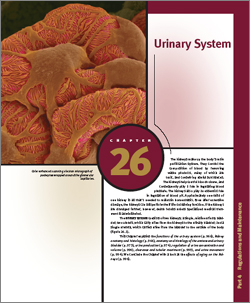
 | The kidneys make up the body's main purification system. They control the composition of blood by removing waste products, many of which are toxic, and conserving useful substances. The kidneys help control blood volume, and consequently play a role in regulating blood pressure. The kidneys also play an essential role in regulation of blood pH. Approximately one-third of one kidney is all that's needed to maintain homeostasis. Even after extensive damage, the kidneys can still perform their life-sustaining function. If the kidneys are damaged further, however, death results unless specialized medical treatment is administered. The urinary system consists of two kidneys; a single, midline urinary bladder; two ureters, which carry urine from the kidneys to the urinary bladder; and a single urethra, which carries urine from the bladder to the outside of the body (figure 26.1). This chapter explains the functions of the urinary system (p. 966), kidney anatomy and histology (p. 966), anatomy and histology of the ureters and urinary bladder (p. 973), urine production (p. 974), regulation of urine concentration and volume (p. 990), clearance and tubular maximum (p. 993), and urine movement (p. 994). We conclude the chapter with a look at the effects of aging on the kidneys (p. 996). |